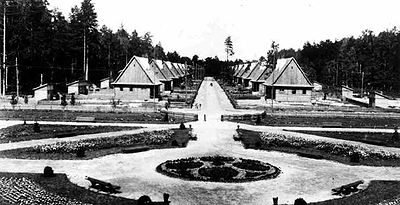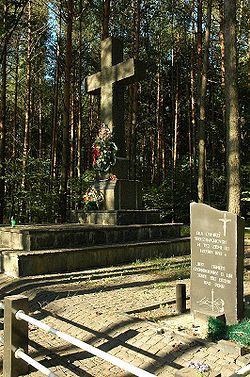
Janowa Dolina
Encyclopedia

Second Polish Republic
The Second Polish Republic, Second Commonwealth of Poland or interwar Poland refers to Poland between the two world wars; a period in Polish history in which Poland was restored as an independent state. Officially known as the Republic of Poland or the Commonwealth of Poland , the Polish state was...
. The name comes from Polish king Jan Kazimierz Waza, who reportedly hunted in the Volhynian forests, and after hunting — rested on the shore of the Horyn river. The village was destroyed during World War II
World War II
World War II, or the Second World War , was a global conflict lasting from 1939 to 1945, involving most of the world's nations—including all of the great powers—eventually forming two opposing military alliances: the Allies and the Axis...
.
First years
The settlement was built in the late 1920s and early 1930s, during a period of Polish colonization of lands within the bordeers of Poland but having a Ukrainian majority population. It was built close to the newly created basalt quarry. Production of basalt in the quarry started in 1929, when the 18km rail connection between Janowa Dolina and Kostopol was completed (Kostopol is located on the main rail route Wilno–LuniniecLuniniec
Luninets is a town and administrative centre for the Luninets district in Brest Province, Belarus, before which it was in Poland and Russia and the Soviet Union . It has a population of some 24,000, and is immediately east of the Pinsk district within Brest...
–Lwow). As the quarry employed in late 1930s some 3,000 workers (97% of them were Polish), lodgings were built for them and their families.
Thus, a town built from scratch was constructed, smack in the forests of central Volynia, by the Horyn River. The quarry and the town were brainchild of engineer Leonard Szutkowski (who kept his post until 1940) and his deputies, engineer J. Niwinski and engineer Urbanowicz. Most workers lived in the freshly built houses; some commuted from nearby villages.
The settlement
Janowa Dolina was a very modern settlement: all houses had access to electricity and plumbing and its layout was based on a specially designed grid planGrid plan
The grid plan, grid street plan or gridiron plan is a type of city plan in which streets run at right angles to each other, forming a grid...
. Houses were placed in the beautiful pine forest. Streets bore no names; they were marked by letters — A, B, C, D… G (Glowna — main), until the last one, Z, placed closest to the Horyn River. Along them there were houses, each designed for 4 families. As inhabitants of Janowa Dolina later remembered, the settlement was full of flowers, plants and trees and neighbors competed with each other, trying to have the most beautiful flower garden. The settlement was separated from the nearby quarry by a strip of dense forest.
In the central part of the settlement there was a huge, U-shaped building, called BLOK. Inside there were several institutions — a movie theater, hotel, cafeteria, stores. Next to the building there was a sports field, with a soccer stadium. The quarry sponsored its own sports club — Strzelec Janowa Dolina
Strzelec Janowa Dolina
Strzelec Janowa Dolina - a defunct Polish sports club, located in the settlement of Janowa Dolina in the Volhynian Voivodeship of the Second Polish Republic. It had numerous departments, including the most popular - soccer...
, which had several departments — soccer, boxing, wrestling, swimming. A Roman Catholic church was planned, but it had never been built. Instead, the faithful used a large barn. Also, in Janowa Dolina there was a Polish police station, school, kindergarten and a health center.
As both the quarry and the settlement belonged to the Polish State, private businesses were not allowed. In Janowa Dolina all trade was controlled by the national “Społem” company, inhabitants were able to purchase all desired products but alcohol, which was not sold in the settlement.
World War II
In September 1939, SovietSoviet Union
The Soviet Union , officially the Union of Soviet Socialist Republics , was a constitutionally socialist state that existed in Eurasia between 1922 and 1991....
troops, following the Molotov-Ribbentrop Pact
Molotov-Ribbentrop Pact
The Molotov–Ribbentrop Pact, named after the Soviet foreign minister Vyacheslav Molotov and the German foreign minister Joachim von Ribbentrop, was an agreement officially titled the Treaty of Non-Aggression between Germany and the Soviet Union and signed in Moscow in the late hours of 23 August 1939...
, attacked the eastern part of Poland
Soviet invasion of Poland (1939)
The 1939 Soviet invasion of Poland was a Soviet military operation that started without a formal declaration of war on 17 September 1939, during the early stages of World War II. Sixteen days after Nazi Germany invaded Poland from the west, the Soviet Union did so from the east...
, which was not guarded by the Polish Army, as at the same time the Poles were fighting the Germans in the West
Invasion of Poland (1939)
The Invasion of Poland, also known as the September Campaign or 1939 Defensive War in Poland and the Poland Campaign in Germany, was an invasion of Poland by Germany, the Soviet Union, and a small Slovak contingent that marked the start of World War II in Europe...
. Eastern Poland (Kresy
Kresy
The Polish term Kresy refers to a land considered by Poles as historical eastern provinces of their country. Today, it makes western Ukraine, western Belarus, as well as eastern Lithuania, with such major cities, as Lviv, Vilnius, and Hrodna. This territory belonged to the Polish-Lithuanian...
) was quickly occupied, together with Janowa Dolina, which, like the entire Volhynian Voivodeship, became part of the Ukrainian Soviet Socialist Republic. Together with Soviet rule came mass deportations to Siberia
Siberia
Siberia is an extensive region constituting almost all of Northern Asia. Comprising the central and eastern portion of the Russian Federation, it was part of the Soviet Union from its beginning, as its predecessor states, the Tsardom of Russia and the Russian Empire, conquered it during the 16th...
and other areas of the empire; between September 1939 and June 1941 Janowa Dolina lost hundreds of inhabitants.
Destruction of the settlement

Nazi Germany
Nazi Germany , also known as the Third Reich , but officially called German Reich from 1933 to 1943 and Greater German Reich from 26 June 1943 onward, is the name commonly used to refer to the state of Germany from 1933 to 1945, when it was a totalitarian dictatorship ruled by...
attacked
Operation Barbarossa
Operation Barbarossa was the code name for Germany's invasion of the Soviet Union during World War II that began on 22 June 1941. Over 4.5 million troops of the Axis powers invaded the USSR along a front., the largest invasion in the history of warfare...
the Soviet Union
Soviet Union
The Soviet Union , officially the Union of Soviet Socialist Republics , was a constitutionally socialist state that existed in Eurasia between 1922 and 1991....
. Janowa Dolina was added to the Reichskommissariat Ukraine
Reichskommissariat Ukraine
Reichskommissariat Ukraine , literally "Reich Commissariat of Ukraine", was the civilian occupation regime of much of German-occupied Ukraine during World War II. Between September 1941 and March 1944, the Reichskommissariat was administered by Reichskommissar Erich Koch as a colony...
. As Volhynia was the area of activity for various Ukrainian nationalist groups whose aim was to cleanse
Ethnic cleansing
Ethnic cleansing is a purposeful policy designed by one ethnic or religious group to remove by violent and terror-inspiring means the civilian population of another ethnic orreligious group from certain geographic areas....
the land of Poles and Jews, the settlement’s fate was inevitable. On the night of April 22–23 (Good Friday), 1943, the Ukrainians from the Ukrainian Insurgent Army, together with local peasants, attacked Janowa Dolina. Some 600 people, including children and the elderly, were brutally murdered (see: Massacres of Poles in Volhynia
Massacres of Poles in Volhynia
The Massacres of Poles in Volhynia and Eastern Galicia were part of an ethnic cleansing operation carried out by the Ukrainian Insurgent Army West in the Nazi occupied regions of the Eastern Galicia , and UPA North in Volhynia , beginning in March 1943 and lasting until the end of...
). Most houses were burned to the ground and the settlement was left deserted.
The perpetrators, commanded by Ivan Lytwynchuk (aka Dubowy) exercised unequaled cruelty. Polish inhabitants, unprepared and caught by surprise, were hacked to death with axes, burned alive, and impaled (including children). The murderers did not spare anyone, regardless of age and sex. German
Wehrmacht
The Wehrmacht – from , to defend and , the might/power) were the unified armed forces of Nazi Germany from 1935 to 1945. It consisted of the Heer , the Kriegsmarine and the Luftwaffe .-Origin and use of the term:...
garrison, numbering around 100 soldiers, did not act and remained in its barracks. After first wave of murders, the Ukrainian nationalists started searching the hospital. They spared its Ukrainian patients, while Polish patients were burned alive. Doctor Aleksander Bakinowski, together with his assistant Jan Borysowicz, were hacked to death on the square in front of the hospital. In several cases, also Ukrainians were murdered, those who hid their Polish neighbors.
Petro Mirchuk
Petro Mirchuk
Petro Mirchuk was a Ukrainian writer living in United States. During and before World War II, he was an activitst for Ukrainian independence. Imprisoned in Auschwitz by Nazi Germany, after the war he emigrated to United States.-References:**...
, Ukrainian historian, counted several hundred massacred Poles, with only eight UPA members killed. This shocking disparity clearly shows that the victims were mostly unarmed.
Currently
Present-day name of the settlement is Bazaltowe. In the place where buildings once stood, there is a monument, founded by Polish survivors. Its opening (April 18, 1998) was marred by a demonstration of Ukrainian nationalists, and afterwards, the original inscription was changed. The date "April 23, 1943" was removed and now the inscription says only "In memory of Poles from Janowa Dolina", without giving further information of their fate.Nowadays in the village monument in memory of infamous action of Ukrainian Insurgent Army (UPA) is situated. The inscription in Ukrainian says that on 21-22 of April 1943 "the base of Polish-German occupiers of Volhyn" was liquidated here.

